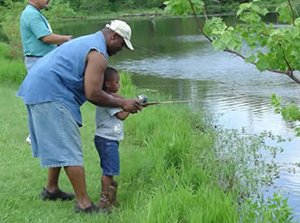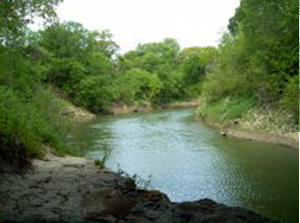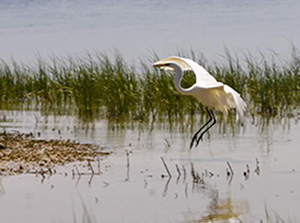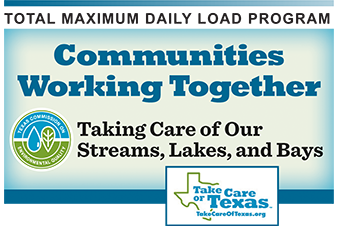Greater Trinity Region




Watershed Counties: Dallas, Tarrant
Parameter: Bacteria
River Basin: Trinity
Segments: 0805, 0806E, 0822A, 0822B, 0841, 0841B, 0841C, 0841E, 0841F, 0841G, 0841H, 0841J, 0841K, 0841L, 0841M, 0841N, 0841R, 0841T, 0841U, 0841V
Greater Trinity Project Navigation
On This Page:
Overview
Bacteria concentrations are occasionally elevated in portions of the Trinity River that flow through Dallas and Tarrant counties. High bacteria concentrations might pose a risk to people who swim or wade in natural waters. Swimming and wading are called “contact recreation” in the state’s standards for water quality; the term refers to all recreation in which people are likely to swallow natural waters.
Watershed Description
The watersheds for the Greater Trinity River I-Plan encompass an area of 406 square miles. The human population is 1.33 million as of 2013, with a population density of approximately 3,232 people per square mile.
Goal
The goal of this project is to reduce bacteria concentrations and protect recreational safety by implementing total maximum daily loads. A TMDL is like a budget for pollutants—it estimates the amount of a pollutant that a water body can receive from categories of sources and still support its designated uses.
Get Involved
In all its projects, TCEQ gathers opinions and information from people who represent government, permitted facilities, agriculture, business, environmental, and community and private interests in the watershed. Stakeholders are a key part of developing solutions for the Greater Trinity Region.
The North Central Texas Council of Governments (NCTCOG) is working with stakeholders to implement bacteria TMDLs throughout their region. Check back here for future meetings or on the NCTCOG website shown above.
Status and Activities
Cities in the watershed continue to address bacteria levels in the impaired waterways covered by the Implementation Plan. Highlights from 2022 include:
-
NCTCOG and entities in the watershed continued to address bacteria levels in the impaired waterways covered by the Implementation Plan (I-Plan). Highlights from 2022 include:
- Drafted and distributed the annual TMDL Questionnaire to stakeholders regarding I-Plan efforts.
- Hosted and facilitated a Bacterial Source Tracking Webinar, which had 98 attendees.
- The Bacterial Source Tracking Webinar recording is available online here, and a copy of the presentation slides are available online here , under the Workshops header.
- Hosted and facilitated an Avian Management Webinar, which had 43 attendees.
- The Avian Management Webinar recording is available online here, and a copy of the presentation slides are available online here , under the Workshops header.
- Completed multiple projects, including the
- “Septic System Maintenance for Homeowners” educational explainer video,
- “Industrial Facilities and MSGPs: What You Need to Know” FAQ document,
- “Don’t Feed the Birds” educational explainer video, and
- “No Muss, No Fuss – Be Wise When You Flush” educational explainer video.
- NCTCOG also started development of the “Doo the Right Thing” (pet waste) educational explainer video and the On-Site Sewage Facility (OSSF, or septic system) mailer.
- Completed the
Greater Trinity River Region TMDL Annual Program Summary
and quarterly newsletters which include information on both current projects and activities completed during the year.
- The quarterly newsletters are available online here , under the Quarterly Newsletters header.
- Coordinated two Upper Trinity River Basin Coordinating Committee meetings to provide a forum for watershed coordinators to communicate regarding current activities and ongoing efforts in the NCTCOG region.
- Facilitated meetings with the TMDL Stormwater , Wastewater , and Monitoring Technical Subcommittees to plan and coordinate projects focused on reducing bacteria loading.
- Facilitated the TMDL Coordination Committee meeting to give program updates, discuss upcoming projects, and to share information about an upcoming TMDL addition for North Fork Cottonwood Creek.
More details about the stakeholders' activities are available on the NCTCOG TMDL Project website and in the 2022 Greater Trinity River Region TMDL Annual Program Summary .
Partners
Arlington Conservation Council
City of Arlington
City of Bedford
City of Cockrell Hill
City of Coppell
City of Dallas
City of Euless
City of Fort Worth
City of Grand Prairie
City of Grapevine
City of Irving
City of Keller
City of Kennedale
City of North Richland Hills
Dallas Area Rapid Transit (DART)
Dallas Downriver Club
Dallas Regional Chamber
Dalworth Soil and Water Conservation District
DFW International Airport
Fort Worth Chamber of Commerce
Greater Fort Worth Sierra Club
North Texas Tollway Authority
Park Cities Municipal Utility District (MUD)
Southwest Paddler
Tarrant County
Tarrant Regional Water District
Texas Department of Transportation (TxDOT)
Trinity River Authority (TRA)
Trinity River Environmental Education Society (TREES)
For More Information
Please email tmdl@tceq.texas.gov, and mention the Greater Trinity River plan in the subject line. Or call us at 512-239-6682.





 Back to top
Back to top